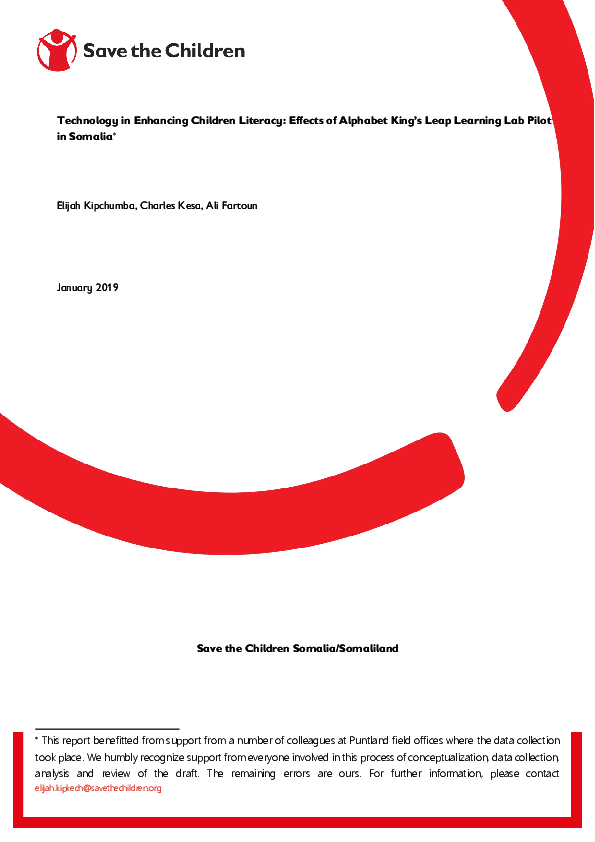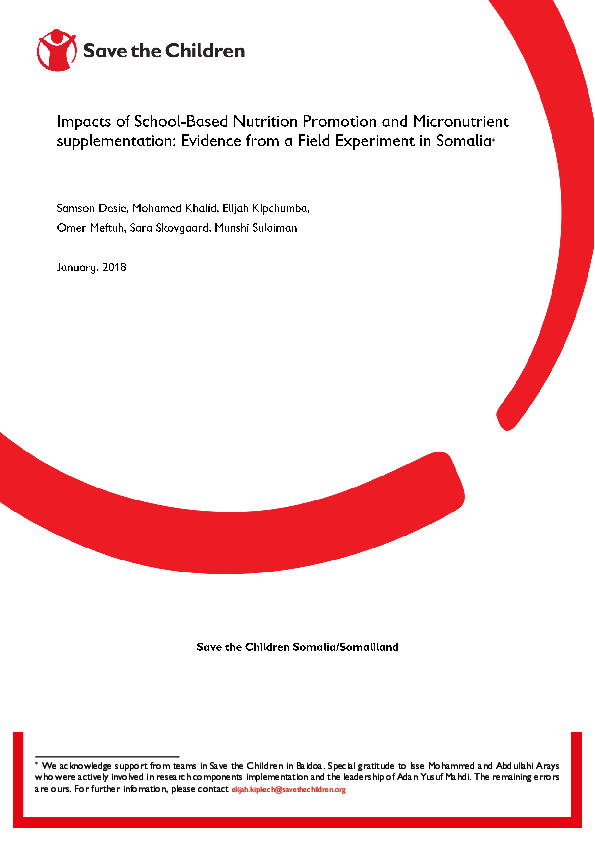
Reports, Study: Research
Technology in Enhancing Children Literacy: Effects of Alphabet King’s Leap Learning Lab Pilot in Somalia
Publication year:
2018
English
Format:
pdf (690.8 KiB)
Publisher:
Save the Children Somalia/Somaliland
Somalia is grappling with low enrolment and retention in primary schools and systemic challenges including reliance on untrained teachers and shortage of teachers among others. Even among enrolled students, illiteracy is high with an estimated 15% to 20% of fourth graders in the country unable to recognise or read single words. This further drives the bulge in illiteracy rates for the next generation. Innovative flexible education approaches suffices to cater for education needs of children in schools and those out of school. Extensive digital infrastructure (smart phones) are already in place within the country, which educators could leverage to support new learning methods. Several studies have demonstrated the potential of education technology in boosting literacy.
SCI-Somalia by piloting Leap Learning Labs (3Ls) sought to act as a proof of concept to boost literacy in post-conflict situations. The labs are equipped with 20 tablets and a corresponding set of tactile material. The tablets were used on a ratio of one student per tablet, additional students in a stream used tactile materials in line with station’s learning activities. In each lab there was a timetable linked to the school master and class timetables. Each student cohort used the lab averagely thrice a week with each session lasting for 45 minutes in line with class timetable. Using a case-comparison approach, 4 schools were paired (2 pairs of 2 schools each) on existing secondary information. Among each school pair, the intervention school was chosen based on access to required rooms and electricity while the other acts as a comparison school. The Early Grade Reading Assessment (EGRA) tool was used to collect pupil data on one-to-one settings. We compared changes in literacy performance of 529 students in literacy sub-tasks between treatment and comparison schools. Additionally, we explored heterogeneity of effects of the 3Ls among gender, grade and baseline level fluency.
This report presents changes in literacy outcomes attributable to the 3Ls about eight months since its initiation. The results show that 3Ls were consistently effective in enhancing literacy in three out of five literacy sub-tasks. Among subtasks, the 3Ls effects were larger in letter sound fluency (0.67 standard deviation (SD)), familiar word fluency (0.66 SD) and unfamiliar word fluency (0.42 SD). Though not significant, the intervention also increased students test scores in oral reading fluency. The study sample was not sufficiently powered to detect sub-group difference, however, results show 3Ls had differential effects among gender, baseline grade and baseline fluency. Male students benefited slightly more than their female counterparts. Students who were in second grade at the onset of the labs maintained a nearly linear growth trajectory in four literacy subtasks as a result of their participation in 3Ls. The intervention neither increased nor reduced performance gap among poorer and best performing students.
Read full abstract
Authors
View & Download
Document information
Publisher
Format
Content type
Country
Region
Rights
© Author/Publisher
Found a mistake? Help us improve!
If you have noticed a document assigned to the wrong author or any other inaccuracies, let us know! Your feedback helps us keep our data accurate and useful for everyone.
Share
Link

